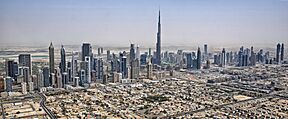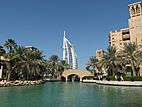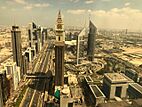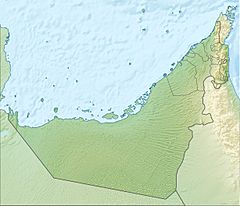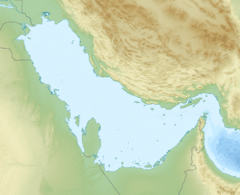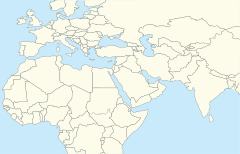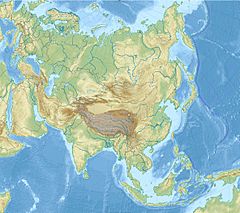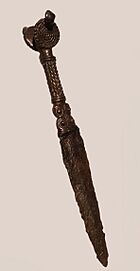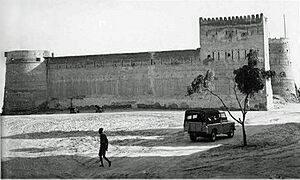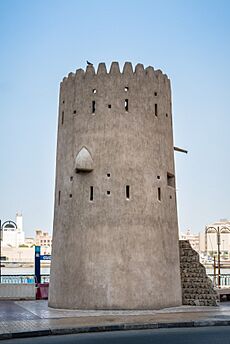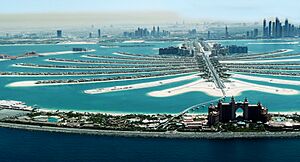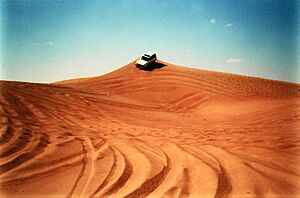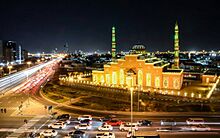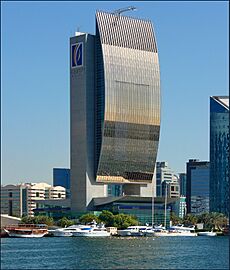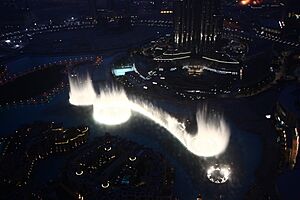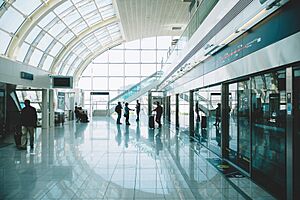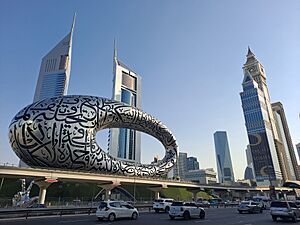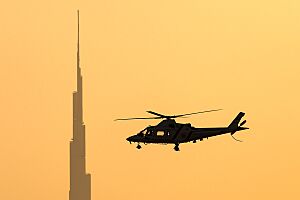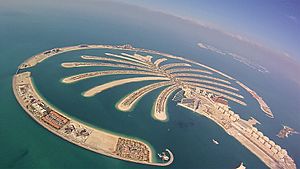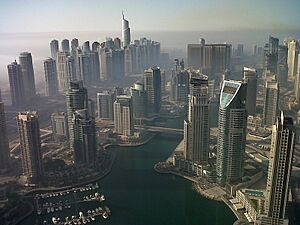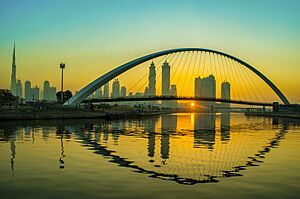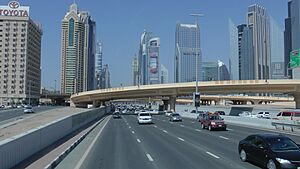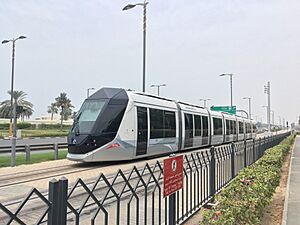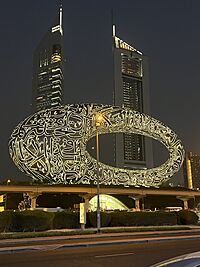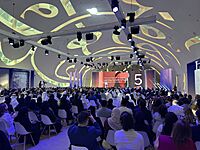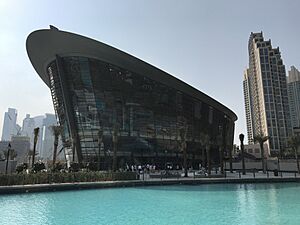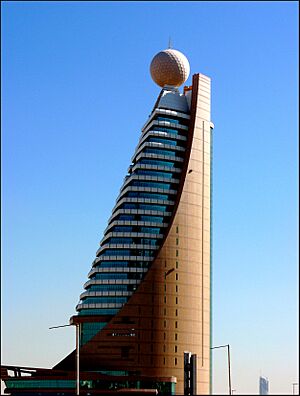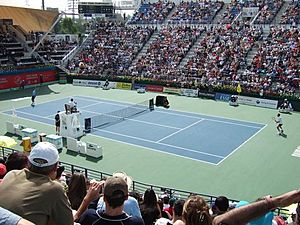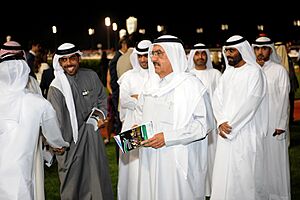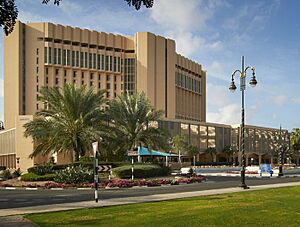Dubai facts for kids
Quick facts for kids
Dubai
دبي
Dubayy
|
|||||
|---|---|---|---|---|---|
|
Dubai's skyline
Burj Khalifa and Downtown
Dubai Creek
Dubai Marina
Palm Jumeirah and The World Islands
Sheikh Zayed Road
|
|||||
|
|||||
| Nicknames:
DXB, Dar Al-Hay, The Pearl of the Gulf, The Venice of the Gulf, The City of the World, The City of Gold
|
|||||
| Country | |||||
| Emirate | |||||
| First mentioned | 1095 | ||||
| First established | 1822 | ||||
| Founded by | Obeid bin Said & Maktoum bin Butti Al Maktoum | ||||
| Government | |||||
| • Type | Absolute monarchy | ||||
| • Body | Dubai Executive Council | ||||
| Area | |||||
| • City | 544 km2 (210 sq mi) | ||||
| • Urban | 1,507 km2 (582 sq mi) | ||||
| Population
(2025)
|
|||||
| • City | 3,944,751 | ||||
| • Density | 7,251/km2 (18,781/sq mi) | ||||
| • Urban | 4,945,000 | ||||
| • Urban density | 3,281.4/km2 (8,499/sq mi) | ||||
| • Metro | 6,359,527 | ||||
| Demonym(s) | Dubaian | ||||
| GDP | |||||
| • City | US$ 134.6 billion (2023) | ||||
| • Metro | US$ 202.8 billion (2023) | ||||
| Time zone | UTC+04:00 (UAE Standard Time) | ||||
Dubai is the largest city in the United Arab Emirates. It is also the capital of the Emirate of Dubai. The city is located on a creek along the south-eastern coast of the Persian Gulf.
As of 2025, Dubai's population is about 4 million people. Most residents are from other countries. The larger urban area, including Sharjah, has about 5 million people. The wider metropolitan area has 6 million residents.
Dubai started as a small village for fishing and pearling in the early 1700s. It grew into a major trading center in the 1900s. This happened after it became a free port in 1901. The city's development sped up from the 1960s to the 1990s. This was thanks to some oil money. Dubai then began to grow its economy in other ways. By 2018, oil made up less than 1% of its economy.
Since the 1990s, Dubai has built many tall buildings. It has one of the world's most impressive skylines. This includes the Burj Khalifa, the world's tallest building. Huge land-reclamation projects have added over 300 kilometers of new coastline. Dubai also has a big market for luxury homes.
Dubai's economy focuses on trade, tourism, aviation, financial services, and real estate. The Dubai International Financial Centre (DIFC) is a major financial hub. In 2024, Dubai was the seventh most-visited city globally. Dubai International Airport (DXB) is the world’s busiest airport for international travel. It handled over 92 million passengers in 2024.
Contents
- Understanding the Name of Dubai
- Dubai's Journey Through Time
- Dubai's Natural Environment
- How Dubai is Governed
- People and Languages of Dubai
- Dubai's Economy and Growth
- Dubai's Unique Architecture
- Burj Al Arab: A Luxury Hotel
- Burj Khalifa: World's Tallest Building
- Palm Jumeirah: An Artificial Island
- The World Islands: A Map in the Sea
- Dubai Miracle Garden: A Flower Wonderland
- Aeternitas Tower: World's Tallest Residential Clock Tower
- Dubai Marina: A Canal City
- Address Beach Resort and Residences
- Getting Around Dubai
- Dubai's Culture and Lifestyle
- Learning and Healthcare in Dubai
- Sister Cities of Dubai
- Images for kids
- See also
Understanding the Name of Dubai
Many ideas explain where the name "Dubai" came from. One idea suggests it came from an old market area. An Arabic saying, "Daba Dubai", means "They came with a lot of money."
A scholar named Fedel Handhal thinks the word "Dubai" might come from dabba. This word means "to creep." It could refer to how slowly the Dubai Creek flows inland.
Another idea from poet Ahmad Mohammad Obaid links it to "baby locust". This is because many locusts lived in the area long ago.
Dubai's Journey Through Time
The area now known as the United Arab Emirates has a long history of human settlement. Ancient findings show strong trade links. These links connected civilizations from the Indus Valley to Mesopotamia. They even reached as far as the Levant.
Archaeological sites in Dubai, like Saruq Al Hadid, show settlements from different ancient periods. The Sumerians knew this area as Magan. It was a source of metals like copper and bronze.
About 5,000 years ago, sand covered the area. The coast moved inland, becoming part of Dubai's current shoreline. Old pottery from the 3rd and 4th centuries has been found. Before Islam, people in this region worshipped Bajir. After Islam spread, the Umayyad Caliphs took control.
An early mention of Dubai was in 1095. It was in a book by the geographer Abu Abdullah al-Bakri. A Venetian pearl merchant, Gasparo Balbi, visited in 1580. He wrote about Dubai's pearling industry.
How Modern Dubai Began
Dubai likely started as a pearling and fishing village in the early 1700s. By 1822, it was a town of 700–800 people. These people were from the Bani Yas tribe. They were under the rule of Abu Dhabi's Sheikh Tahnun bin Shakhbut. A British surveyor noted in 1822 that Dubai had a thousand people. They lived in an oval-shaped town with a mud wall.
In 1833, some members of the Al Bu Falasah tribe left Abu Dhabi. They settled in Dubai after tribal conflicts. Obeid bin Saeed and Maktoum bin Butti bin Suhail led this group. They became joint leaders of Dubai. After Obeid died in 1836, Maktoum started the Maktoum dynasty.
Dubai signed a treaty with the British government in 1820. This was after a British campaign in 1819. It led to the 1853 Perpetual Maritime Truce. Dubai also agreed in 1892 that the United Kingdom would handle its security.
In 1841, a smallpox outbreak happened in Bur Dubai. This made people move east to Deira. In 1896, a big fire destroyed many homes in Dubai. Most houses were made of palm fronds. Half of Bur Dubai's homes burned, and Deira was completely destroyed. More fires happened the next year.
In 1901, Maktoum bin Hasher Al Maktoum made Dubai a free port. This meant no taxes on imports or exports. He also gave land to merchants and promised them safety. These rules attracted merchants from other areas. Dubai quickly became a main trading hub. By 1906, it had replaced Lingeh as the chief trading center.
A "great storm" hit Dubai's pearling boats in 1908. Many boats and over 100 men were lost. This was a big problem for Dubai. Many families lost their main providers. Merchants faced financial ruin.
Dubai Before Oil Was Discovered
Dubai was a key center for collecting and trading pearls. When the pearling industry collapsed, the city faced hard times. Many people became poor or moved to other parts of the Persian Gulf.
In 1937, an oil exploration deal was signed. This gave Dubai royalty rights. But because of World War II, oil was not found until 1966.
In its early days, Dubai often had disagreements with Abu Dhabi. In 1947, a border dispute led to a small conflict. The British government helped them stop fighting.
Even without oil, Dubai's ruler from 1958, Sheikh Rashid bin Saeed Al Maktoum, used trade money to build things. He got loans from local merchants and Kuwait. Companies were set up for electricity, phones, ports, and the airport. A basic airport was built in the 1950s. Dubai's first hotel opened in 1959.
In the late 1950s, British officials suggested a city plan. Sheikh Rashid invited architect John Harris in 1959. Harris created a plan in 1960. By 1961, a British engineering firm was already building streets based on this plan. The plan helped guide Dubai's growth.
In 1959, Dubai's first telephone company started. In 1961, electricity and phone networks were working. A water company also built pipelines. By 1968, Dubai had a good water supply.
On April 7, 1961, a British ship, the MV Dara, was caught in a storm near Dubai. An explosion happened, causing fires. Many small boats from Dubai and nearby areas rescued survivors. But 238 people were lost.
Construction of Dubai's first airport began in 1959. The terminal opened in September 1960. By 1965, the airport had an asphalt runway. This allowed more flights. A new terminal was built in 1970.
Throughout the 1960s, Dubai was a busy center for gold trade. In 1968, about £56 million worth of gold was imported. Most of this gold was then sent to other places, especially India.
The Oil Era and Modern Growth
After years of searching, oil was found in Dubai's waters in 1966. The first oil field was called "Fateh," meaning "good fortune." This discovery sped up Sheikh Rashid's plans. It led to a building boom. Many foreign workers came to Dubai. Between 1968 and 1975, the city's population grew by over 300%.
To store oil from the Fateh field, two huge tanks were built. They were welded on the beach and then moved to the seabed. This allowed large oil tankers to load offshore.
Oil money started flowing in 1969. Sheikh Rashid used this money to build more infrastructure. He wanted to create a diverse economy before the oil ran out. Oil made up 24% of Dubai's economy in 1990. By 2004, it was only 7%.
One of the first big projects was Port Rashid. This was a deep-water free port. It was a huge success. Ships lined up to use the new facilities. The port opened in 1972. It was expanded further in 1975. Later, the even larger Jebel Ali port was built. These projects helped create a modern trading system. They also led to new roads, bridges, schools, and hospitals.
Forming the United Arab Emirates

Dubai and the other "Trucial States" were under British protection. The British handled their foreign policy and defense. But on January 16, 1968, British Prime Minister Harold Wilson announced that British troops would leave the region. This led to talks among the emirates, Qatar, and Bahrain. They needed to form a new union.
The idea of a union was first agreed upon by Sheikh Zayed bin Sultan Al Nahyan of Abu Dhabi and Sheikh Rashid of Dubai. This happened on February 18, 1968. They wanted to include other emirates. After many meetings, six of the seven "trucial" emirates agreed to unite on July 18, 1971.
On December 2, 1971, Dubai, Abu Dhabi, Sharjah, Ajman, Umm al-Quwain, and Fujairah formed the United Arab Emirates. Ras Al Khaimah joined later, on February 10, 1972.
In 1973, Dubai adopted a single currency with the other emirates. This was the UAE dirham.
Dubai Today: A Global City
Throughout the 1970s, Dubai continued to grow. Oil money and trade fueled this growth. Many immigrants also arrived, fleeing the Lebanese civil war. Border disputes between the emirates continued even after the UAE was formed. These were settled in 1979.
In 1979, the Jebel Ali port was built. This deep-water port could handle very large ships. To help it succeed, Sheikh Mohammed started the JAFZA (Jebel Ali Free Zone) in 1985. This zone allowed foreign companies to easily bring in workers and send out money. Dubai's airport and aviation industry also kept growing.
The Gulf War in 1991 affected Dubai financially. But the city recovered well. In the late 1990s, many foreign businesses moved to Dubai. Dubai also served as a supply base for allied forces during the Gulf War and the 2003 Invasion of Iraq. Rising oil prices encouraged Dubai to keep focusing on trade and tourism.
In the early 2000s, artificial islands were built. These include the Palm Islands and The World Islands. The Burj Khalifa opened in 2010. It became the tallest skyscraper in the world.
Dubai has "smart city" plans. These aim to use technology to improve the city. In 2016, the world's first working 3D-printed office building opened in Dubai. It took only 17 days to build.
Dubai's Natural Environment
Dubai is on the Persian Gulf coast of the United Arab Emirates. It is about 16 meters above sea level. The emirate of Dubai borders Abu Dhabi to the south. It also borders Sharjah to the northeast and Oman to the southeast. Hatta, a small part of Dubai, is surrounded by Oman and other emirates. The Persian Gulf is on Dubai's western coast. Dubai covers an area of 1,588 square miles. This is much larger than its original size due to land reclaimed from the sea.
Dubai is located in the Arabian Desert. However, its landscape is different from southern UAE. Dubai has many sandy desert areas. The sand is fine, clean, and white. It is mostly made of crushed shells and coral. East of the city, flat coastal areas turn into sand dunes. Further east, the dunes become larger and are reddish from iron oxide.
The flat desert leads to the Western Hajar Mountains. These mountains run along Dubai's border with Oman. The Hajar mountains are dry and rugged. Some peaks rise to about 1,300 meters. Dubai has no natural rivers or oases. But it has a natural inlet, Dubai Creek. This creek has been deepened for large ships. There are also gorges and waterholes in the Hajar mountains. A large area of dunes covers southern Dubai. This leads into the vast desert known as The Empty Quarter.
Dubai is in a very stable earthquake zone. The nearest fault line is far away. Experts also believe a tsunami is unlikely. This is because the Persian Gulf waters are not deep enough.
The sandy desert around Dubai has wild grasses and date palms. Desert hyacinths grow in coastal plains. Acacia and ghaf trees grow near the Hajar mountains. Dubai's parks have native trees like date palms and neem. They also have imported trees like eucalyptus and jacaranda.
Animals like the MacQueen's bustard, striped hyena, caracal, desert fox, falcon, and Arabian oryx live in Dubai's desert. Dubai is on a path for migrating birds. Over 320 bird species pass through in spring and autumn. Dubai's waters have over 300 types of fish. This includes the hammour. Marine life also includes tropical fish, jellyfish, coral, dugong, dolphins, whales, and sharks. Endangered turtles like the hawksbill and green turtle are found here.
Dubai's Climate
| Climate data for Dubai (1991–2020) | |||||||||||||
|---|---|---|---|---|---|---|---|---|---|---|---|---|---|
| Month | Jan | Feb | Mar | Apr | May | Jun | Jul | Aug | Sep | Oct | Nov | Dec | Year |
| Record high °C (°F) | 31.8 (89.2) |
37.5 (99.5) |
41.3 (106.3) |
44.6 (112.3) |
47.0 (116.6) |
47.9 (118.2) |
49.0 (120.2) |
48.8 (119.8) |
45.1 (113.2) |
42.4 (108.3) |
38.1 (100.6) |
33.2 (91.8) |
49.0 (120.2) |
| Mean daily maximum °C (°F) | 23.9 (75.0) |
25.4 (77.7) |
28.9 (84.0) |
33.3 (91.9) |
37.7 (99.9) |
39.8 (103.6) |
40.9 (105.6) |
41.3 (106.3) |
38.9 (102.0) |
35.4 (95.7) |
30.6 (87.1) |
26.2 (79.2) |
33.5 (92.3) |
| Daily mean °C (°F) | 19.1 (66.4) |
20.5 (68.9) |
23.6 (74.5) |
27.5 (81.5) |
31.4 (88.5) |
33.4 (92.1) |
35.5 (95.9) |
35.9 (96.6) |
33.3 (91.9) |
29.8 (85.6) |
25.4 (77.7) |
21.2 (70.2) |
28.1 (82.5) |
| Mean daily minimum °C (°F) | 14.3 (57.7) |
15.5 (59.9) |
18.3 (64.9) |
21.7 (71.1) |
25.1 (77.2) |
26.9 (80.4) |
30.0 (86.0) |
30.4 (86.7) |
27.7 (81.9) |
24.1 (75.4) |
20.1 (68.2) |
16.3 (61.3) |
22.5 (72.6) |
| Record low °C (°F) | 7.7 (45.9) |
7.4 (45.3) |
11.0 (51.8) |
13.7 (56.7) |
15.7 (60.3) |
19.6 (67.3) |
24.1 (75.4) |
24.0 (75.2) |
22.0 (71.6) |
15.0 (59.0) |
10.8 (51.4) |
8.2 (46.8) |
7.4 (45.3) |
| Average precipitation mm (inches) | 20.8 (0.82) |
9.9 (0.39) |
21.7 (0.85) |
3.3 (0.13) |
0.1 (0.00) |
0.02 (0.00) |
1.1 (0.04) |
0.003 (0.00) |
0.04 (0.00) |
1.5 (0.06) |
5.9 (0.23) |
14.8 (0.58) |
79.2 (3.12) |
| Average precipitation days (≥ 1 mm) | 2.8 | 2.4 | 3.4 | 1.5 | 0.4 | 0.1 | 0.5 | 0.5 | 0.2 | 0.3 | 1.3 | 3.8 | 17.2 |
| Average relative humidity (%) | 65 | 64 | 61 | 54 | 50 | 55 | 55 | 53 | 59 | 60 | 61 | 65 | 58.7 |
| Mean monthly sunshine hours | 253.1 | 250.8 | 288.0 | 315.6 | 350.0 | 344.5 | 340.3 | 333.9 | 307.8 | 300.0 | 268.1 | 256.9 | 3,608.9 |
| Mean daily sunshine hours | 8.1 | 8.6 | 8.7 | 10.2 | 11.3 | 11.5 | 10.7 | 10.5 | 10.3 | 9.9 | 9.3 | 8.2 | 9.8 |
| Average ultraviolet index | 5 | 7 | 9 | 11 | 12 | 12 | 12 | 12 | 11 | 9 | 6 | 5 | 9 |
| Source 1: NOAA (humidity 1981-2010), Dubai Meteorological Office (daily sun 1974-2009) | |||||||||||||
| Source 2: UAE National Center of Meteorology | |||||||||||||
Dubai has a hot desert climate. Summers are very hot, long, windy, and humid. The average high in August is around 40°C. Overnight lows are about 30°C. Most days are sunny all year. Winters are mild to warm. The average high in January is 24°C. Overnight lows are 14°C.
Dubai summers are also known for high humidity. This can make it feel very uncomfortable. The highest temperature recorded in Dubai is 49.0°C.
Dubai is very dry. The average yearly rainfall is 79.2 mm. However, rainfall has increased in recent decades. In April 2024, record-setting flooding happened in Dubai. This showed a need for better drainage systems.
How Dubai is Governed

The Al Maktoum family has ruled Dubai since 1833. Dubai is an absolute monarchy. Citizens vote for representatives to the Federal National Council of the UAE. The current ruler, His Highness Sheikh Mohammed bin Rashid Al Maktoum, is also the Vice-President and Prime Minister of the United Arab Emirates. He is a member of the Supreme Council of the Union. Dubai appoints 8 members to the Federal National Council.
The Dubai Municipality (DM) was created in 1954. It handles city planning, services, and facility upkeep. It has grown into an independent authority. This authority is called the Government of Dubai. It is responsible for both the city and the wider emirate. The Government of Dubai has over 58 departments. These handle security, economy, education, and more. Dubai is one of three emirates with its own court system.
The Ruler of Dubai is the head of government and state. Laws are issued in his name. Since 2003, the Dubai Executive Council manages government agencies. It is led by the Crown Prince of Dubai Hamdan bin Mohammed Al Maktoum. There is no legislative assembly. But traditional open majlis meetings are held. Citizens and the Ruler's representatives meet to discuss local issues.
People and Languages of Dubai
| Historical population | ||
|---|---|---|
| Year | Pop. | ±% |
| 1822 | 1,200 | — |
| 1900 | 10,000 | +733.3% |
| 1930 | 20,000 | +100.0% |
| 1940 | 38,000 | +90.0% |
| 1960 | 40,000 | +5.3% |
| 1968 | 58,971 | +47.4% |
| 1975 | 183,000 | +210.3% |
| 1985 | 370,800 | +102.6% |
| 1995 | 674,000 | +81.8% |
| 2005 | 1,204,000 | +78.6% |
| 2010 | 1,905,476 | +58.3% |
| 2015 | 2,446,675 | +28.4% |
| 2019 | 3,355,900 | +37.2% |
| c-census; e-estimate | ||
As of September 2019, Dubai's population was 3,331,420. This was a 5.64% increase from the previous year. The population density is high. Dubai is the second most expensive city in the region. It is the 20th most expensive city globally.
As of 2013, only about 15% of the population were UAE nationals. The rest were people from other countries. Many of these expatriates have lived in the UAE for generations. About 85% of the expatriate population was Asian. This included Indians (51%) and Pakistanis (16%). Other groups included Bangladeshis (9%) and Filipinos (3%). About a quarter of the population has roots in Iran. Many Westerners also live in the UAE. Over 100,000 British people live in Dubai.
Arabic is the official language of the UAE. Most Emiratis speak the Gulf dialect. English is widely used as a second language. Many other languages are spoken due to immigration. These include Malayalam, Sindhi, Gujarati, Urdu, Persian, Hindi, Tamil, Punjabi, Pashto, Bengali, Balochi, Tulu, Kannada, Sinhala, Marathi, Telugu, Tagalog, and Chinese.
Religious Diversity in Dubai
Islam is the official state religion of the UAE. The government supports most mosques. All mosques in Dubai are managed by the Islamic Affairs and Charitable Activities Department. The UAE Constitution allows for freedom of religion.
| Religion in Dubai (2014) | ||||
|---|---|---|---|---|
| Religion | Percent | |||
| Islam | 56% | |||
| Christian | 25% | |||
| Hindu | 16% | |||
| Others | 2% | |||
Dubai has many Christian, Hindu, Sikh, Baháʼí, Buddhist, and Jain communities. There is also a small but growing Jewish community. In 2014, over 56% of Dubai residents were Muslims. 25% were Christians, and 16% were Hindus. About 2% followed other religions. The Churches Complex in Jebel Ali Village has several churches and temples.
Non-Muslim groups can have their own places of worship. They can get land and permission to build. Groups without their own buildings can use others' facilities or worship at home. They can also advertise events and share religious materials.
Dubai's Economy and Growth

Dubai has one of the world's fastest-growing economies. Its economy was projected at over US$177 billion in 2021. Oil and natural gas make up less than 5% of Dubai's income. Dubai produces some oil and gas from offshore fields. However, Dubai's oil reserves are decreasing. They are expected to run out in about 20 years. Real estate and construction, trade, and financial services are the biggest parts of Dubai's economy.
Dubai's non-oil foreign trade was $362 billion in 2014. Imports were $230 billion. Exports and re-exports were $31 billion and $101 billion.
By 2014, China was Dubai's largest trading partner. Trade with China was $47.7 billion. India was second with $29.7 billion. The United States was third with $22.62 billion. Saudi Arabia was Dubai's fourth largest trading partner.
Historically, Dubai and Deira were important trading ports. Most banking centers were in the port area. Dubai remained a key trade route in the 1970s and 1980s. Dubai has a free trade in gold. Until the 1990s, it was a hub for gold trade to India. India had rules on gold imports.
Dubai's Jebel Ali port was built in the 1970s. It has the world's largest human-made harbor. It ranks seventh globally for container traffic. Dubai is also a hub for services like information technology and finance. It has special free zones for these industries. Dubai Internet City and Dubai Media City are examples. They host major IT and media companies.
The Dubai Financial Market (DFM) started in 2000. It is a market for trading stocks and bonds. As of late 2006, its trading volume was about $95 billion. NASDAQ Dubai is another stock exchange. It helps companies trade internationally.
The DMCC was set up in 2002. It is a fast-growing free zone. Dubai is also called the "City of Gold." A large part of its economy comes from gold trading. In early 2011, Dubai traded 580 tonnes of gold.
A survey in 2007 ranked Dubai 44th among the world's best financial cities. Another report in 2012 said Dubai was the 27th richest city. Dubai is also an international financial centre. It was ranked 37th globally in 2007. It was first in the Middle East. The Dubai IFC has attracted many international firms.
In 2012, Dubai was ranked 40th in the Global City Competitiveness Index. By 2025, it is expected to move up to 23rd place. People from India, Britain, and Pakistan are the top foreign investors in Dubai real estate.
Dubai has started big projects to boost its economy. These include Dubai Fashion 2020 and Dubai Design District. The design district aims to be a home for designers. Its first phase was completed in 2015.
As of March 2024, Dubai started operating the world's largest waste-to-energy plant. It will power about 135,000 homes. In July 2024, Dubai signed a deal to build the world's largest food logistics hub. In 2024, Dubai ranked 12th out of 142 cities in the Smart City Index.
Real Estate and Property Development
In September 2019, Dubai's ruler ordered a committee to plan real estate projects. This was to balance supply and demand. It aimed to slow down construction after property prices dropped.
The government wanted to grow beyond oil and trade. It focused on services and tourism. This made property more valuable. Prices went up from 2004 to 2006. However, some properties lost value from 2001 to 2008.
Large building projects created some of the world's tallest skyscrapers. These include the Emirates Towers, the Burj Khalifa, and the Palm Islands. The Burj Al Arab is one of the most luxurious hotels. Dubai's property market faced a big slowdown in 2008 and 2009. This was due to the global economic crisis. Property values, construction, and jobs were affected.
Property prices in Dubai increased a lot after February 2022. This was because many wealthy people invested in real estate. Since 2020, property prices in Dubai have increased by 124%. This rise in prices has led some people to look for homes outside Dubai.
Despite rising prices, real estate deals in Dubai are at a record high. In 2024, there were 180,987 transactions. These were worth AED 522.5 billion. This is a 36.5% increase from 2023.
Tourism and Shopping Experiences
Tourism is a key part of Dubai's plan to bring in foreign money. Dubai attracts tourists mainly for shopping. It also has many old and new attractions. As of 2018, Dubai was the fourth-most-visited city globally. It was also the fastest growing, with a 10.7% increase. The city hosted 14.9 million visitors in 2016. It aimed for 20 million tourists by 2020. A major attraction is the Burj Khalifa, the world's tallest building.
Dubai is known as the "shopping capital of the Middle East." It has over 70 shopping centers. This includes The Dubai Mall, one of the world's largest. As of June 2024, plans were announced to expand The Dubai Mall. This expansion will add 240 luxury stores and new food places.
Dubai is also famous for its historic market areas, called souks. These are on both sides of the creek. In the past, boats from Asia would unload goods here. These goods were then traded in the souks. The Dubai Creek was very important for the city's growth. It has been suggested as a UNESCO World Heritage Site. Many luxury shops and jewelry stores are also in the city. Dubai is called "the City of Gold" because the Gold Souk has nearly 250 gold shops.
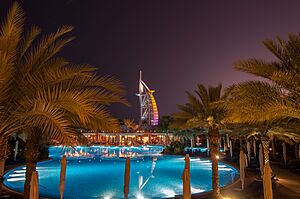
Dubai Creek Park is also important for tourism. It has attractions like the Dolphinarium and Cable Car. Dubai has many parks, such as Safa Park and Mushrif Park. Mushrif Park shows different houses from around the world.
Popular beaches in Dubai include Umm Suqeim Beach and JBR Open Beach. A 2019 study found that tourists spend more money in Dubai than in any other country. In 2018, Dubai topped the list for the fourth year. Tourists spent $30.82 billion, averaging $553 per day.
In October 2019, Dubai made it easier for tourists to buy certain items from special stores. This change happened as the UAE faced economic challenges.
Expo 2020 in Dubai

In November 2011, Dubai submitted its bid to host Expo 2020. Officials who visited Dubai in 2013 were impressed by its readiness. In May 2013, the Dubai Expo 2020 Master Plan was revealed. Dubai won the right to host Expo 2020 on November 27, 2013.
The main site for Expo 2020 was a 438-hectare area. It was part of the new Dubai Trade Centre Jebel Ali development. This site is between Dubai and Abu Dhabi. Expo 2020 also started projects to help the city. This included a large solar power project.
Expo 2020 was planned to run from October 20, 2020, to April 10, 2021. It would have 192 country pavilions. These would show stories from around the world. There would also be themed areas for learning.
Due to the COVID-19 pandemic, Expo 2020 was postponed. It took place from October 1, 2021, to March 31, 2022.
Dubai aims to be a city that is easy for everyone to use. This includes people with disabilities. The city has added wheelchair-friendly taxis and sloped pavements. Metro stations have tactile indicators for visually impaired people. The Expo site has now become Expo City Dubai.
Dubai's Unique Architecture

Dubai has many buildings with different architectural styles. You can see many modern examples of Islamic architecture here. This is due to a building boom in the Arab World. Top design firms have helped create these structures. Modern Islamic architecture has reached new heights in skyscraper design. Dubai now has more tall skyscrapers than any other city.
The Burj Khalifa was finished in 2010. It is the world's tallest building at 829.8 meters. Its design is based on Islamic patterns. The building's shape comes from the desert flower hymenocallis. The completion of the Burj Khalifa gave Dubai the world's tallest skyline. "At The Top" in Burj Khalifa is a popular tourist spot. It is the world's second-highest outdoor observation deck. Over 1.87 million people visited in 2013.
The Creek Tower was planned to be even taller. But its construction was paused during the coronavirus pandemic. No new start date has been announced. Dubai is recognized as a "Design City" by UNESCO.
Burj Al Arab: A Luxury Hotel
The Burj Al Arab is a very luxurious hotel. It is often called a "7-star" hotel. However, the hotel itself does not use this term. It calls itself a "five-star deluxe property." A British journalist first used the "7-star" term. The hotel opened in December 1999.
Burj Khalifa: World's Tallest Building
Burj Khalifa is a skyscraper in Dubai. It is 828 meters tall. It is the tallest building in the world. The tower's design was inspired by the Hymenocallis desert flower. Over 30 companies and workers from 100 countries built it. Construction started in 2004 and finished in 2009. It is named after Sheikh Khalifa bin Zayed Al Nahyan. The building opened on January 4, 2010.
Palm Jumeirah: An Artificial Island
The Palm Jumeirah is an artificial archipelago. It was built by Nakheel Properties, a Dubai government company. It was created using land reclamation. It is one of three planned islands called the Palm Islands. These islands extend into the Persian Gulf. Palm Jumeirah is the smallest and first of these islands. It is located in the Jumeirah area of Dubai. It was built from 2001 to 2006.
The World Islands: A Map in the Sea
The World Islands are small artificial islands. They are shaped like a world map. They are located 4.0 kilometers off Dubai's coast. The islands are mostly made of sand from Dubai's shallow waters. Each island is between 250,000 and 900,000 square feet. The whole group of islands covers about 9 km in width.
Dubai Miracle Garden: A Flower Wonderland
On February 14, 2013, the Dubai Miracle Garden opened. It is a 72,000 square meter flower garden in Dubailand. It is the world's largest flower garden. It has over 50 million flowers and 70 plant species. The garden uses recycled wastewater from the city. It waters plants using a drip irrigation system. The garden closes during the hot summer months.
Aeternitas Tower: World's Tallest Residential Clock Tower
In early January 2024, Dubai announced plans for the Aeternitas Tower. It will be the world's tallest residential clock tower. It will be 450 meters tall. This is four times the height of London's Big Ben. The tower's name, "Aeternitas," comes from an ancient Roman idea of eternity. This project is a partnership between London Gate and Franck Muller. The tower will have luxury apartments.
Dubai Marina: A Canal City
Dubai Marina is an artificial canal city. It is built along a 3-kilometer stretch of the Persian Gulf shoreline. As of 2018, its population was 55,052. When finished, it will house over 120,000 people. The Dubai Marina has a 3.5-kilometer water canal. This canal is central to the development. It offers access to the sea, making Dubai Marina a sailing spot. It is located near Jebel Ali Port and areas like Dubai Internet City. The first part of this project is complete. Dubai Marina was inspired by a development in Vancouver, Canada. Marine animals like whales and sharks sometimes enter the marina.
Address Beach Resort and Residences
This structure has two towers connected at the bottom. A sky bridge connects them at the top, from the 63rd to the 77th floors. This sky bridge has luxury apartments. It is the world's highest occupiable sky bridge floor, at 294.36 meters. It opened in December 2020. The towers also have the world's highest infinity pool in a building. It is on the roof, at 293.906 meters high.
Getting Around Dubai
Transportation in Dubai is managed by the Roads and Transport Authority (RTA). This agency was formed in 2005. Dubai has invested a lot to improve its public transport. Over AED 70 billion was planned for improvements by 2020. In 2009, there were about 1,021,880 cars in Dubai. In January 2010, 6% of residents used public transport.
Road Network
Five main roads run through Dubai. These connect the city to other towns and emirates. Important city roads also connect different areas. Bridges and tunnels connect the eastern and western parts of the city. These include Al Maktoum Bridge and Al Shindagha Tunnel.
The RTA runs Dubai's public bus system. The bus system has 140 routes. It carried over 109 million people in 2008. By late 2010, there were 2,100 buses. In 2006, the RTA built 500 air-conditioned bus shelters. They planned 1,000 more to encourage bus use.
All taxi services are licensed by the RTA. Dubai taxis are cream-colored. Their roof colors show the operator. Dubai Taxi Corporation is the largest operator. There are also private operators. A Ladies and Families taxi service has female drivers. Over 3,000 taxis operate in Dubai. They make about 192,000 trips daily.
Air Travel

Dubai International Airport (DXB) is a hub for Emirates airline. It serves Dubai and other emirates. It is the third-busiest airport globally for passenger traffic. It is the world's busiest for international passenger traffic. It is also the sixth-busiest cargo airport. It handled 2.37 million tons of cargo in 2014. Emirates flies to over 150 places in more than 70 countries.
The Al Maktoum International Airport (DWC) was announced in 2004. Its first phase has opened. When finished, it will be the world's largest airport. It will have five runways and four terminals. It will handle 160 million passengers and 12 million tons of cargo.
Rail Transport
The Dubai Metro has two lines: Red and Green. They run through the city's financial and residential areas. It opened in September 2009. The Red Line has 29 stations. It runs from Rashidiya to UAE Xchange Station. The Green Line has 20 stations. An extension to the Red Line opened on June 1, 2021. This connects to the EXPO 2020 site. Blue and Purple Lines are also planned. The Dubai Metro is the first urban train network in the Arabian Peninsula. The trains are fully automated and driverless.
A monorail line connects the Palm Jumeirah to the mainland. It opened on April 30, 2009. It is the first monorail in the Middle East. An extension to connect to the Dubai Metro is planned.
A tramway in Al Sufouh runs for 14.5 km. It connects Dubai Marina to the Burj Al Arab. It has two connections with the Dubai Metro Red Line. The first part opened in 2014.
Dubai plans to link to the UAE high-speed rail system. This system will connect to the entire GCC region. It might also connect to Europe. The high-speed rail will carry passengers and cargo.
Waterways for Travel and Trade
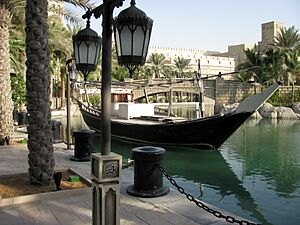
Dubai has two main commercial ports: Port Rashid and Port Jebel Ali. Port Jebel Ali is the world's largest human-made harbor. It is the biggest port in the Middle East. It is also the 7th-busiest port globally.
A traditional way to cross the Dubai Creek is by abras. These are small boats that carry passengers. They run between Bastakiya and Baniyas Road. The Marine Transport Agency also has the Dubai Water Bus System. This is an air-conditioned boat service. You can also take a tourist water bus. The Water Taxi is the newest addition. It carries up to 20 passengers. It offers smooth journeys along Al Mamzar and Dubai Marina. It has 40 pick-up points.
Dubai is growing its ports for trade between Europe and China or Africa. This is in addition to oil transport. Ports like Jebel Ali are being expanded. Investments are made in new technology. Dubai is part of the Maritime Silk Road. This route connects China to Europe.
Dubai's Culture and Lifestyle
The UAE's culture mostly reflects traditional Arab culture. Arab and Islamic influences are strong in architecture, music, clothing, food, and daily life. Muslims are called to prayer five times a day from mosque minarets. Major holidays include Eid al-Fitr (end of Ramadan) and National Day (December 2). National Day celebrates the formation of the United Arab Emirates.
Dubai's culture changed as more people from other countries arrived. Iranians came in the early 1900s. Indians and Pakistanis arrived in the 1960s. In 2005, 84% of Dubai's population was foreign-born. About half of them were from India.
From 2006 to 2022, the weekend was Friday and Saturday. This was a mix of Muslim and Western traditions. Before 2006, it was Thursday and Friday. On January 1, 2022, Dubai changed to a four-and-a-half-day work week. The weekend now includes Friday afternoon, Saturday, and Sunday.
Dubai's focus on tourism and high living standards has shaped its culture. It is known for luxury and entertainment. Dubai has a lively nightlife. Clubs and bars are mostly in hotels due to local rules.
Annual events like the Dubai Shopping Festival (DSF) attract many visitors. They bring in over $2.7 billion in revenue. In 2012, Dubai was named "IFEA World Festival and Event City."
Large shopping malls are popular. These include The Dubai Mall and Mall of the Emirates. Traditional souks like the Dubai Gold Souk also attract shoppers.
Food and Dining in Dubai
Arabic cuisine is very popular in Dubai. You can find it everywhere, from small shawarma shops to hotel restaurants. Fast food, South Asian, and Chinese foods are also common. The sale of pork is allowed only for non-Muslims. It is sold in special areas of supermarkets and airports. Shisha and qahwa (coffee) shops are also popular. Biryani is a favorite dish, especially among Indian and Pakistani residents.
The first Dubai Food Festival was held in 2014. It aimed to show Dubai as a top food city. The festival featured foods from over 200 nationalities. The next food festival was held in 2017.
Entertainment and Arts
The Dubai Opera opened on August 31, 2016. It is in Downtown Dubai. It is a 2000-seat center for performing arts. It hosts shows, concerts, operas, weddings, and conferences. Arabic movies are popular in Dubai. Since 2004, the city has hosted the annual Dubai International Film Festival. This festival showcases Arab and Middle Eastern films.
Dubai has a growing contemporary art scene. Galleries like Carbon 12 Dubai and Green Art have put the city on the international art map. Art Dubai is a respected art fair in the region. The Theatre of Digital Art Dubai (ToDA) opened in 2020. It shows immersive digital art.
Media and Communication
Many international news agencies have offices in Dubai Media City. These include Reuters, APTN, and Bloomberg. Local TV channels like Dubai One and Dubai TV offer programs in English and Arabic. Dubai is also home to several newspapers. Dar Al Khaleej and Al Bayan are major Arabic newspapers. Gulf News and Khaleej Times are leading English newspapers.
Etisalat is the main telecommunications provider. Internet was introduced to Dubai in 1995. Internet content is regulated in Dubai. In 2002, Dubai passed a law for electronic transactions. In 2019, Italian artist Princess Bee created "Hi Dubai." This series showed the city's spirit through the lives of 25 women. It was shown on Dubai One TV.
Sports and Recreation
Football and cricket are the most popular sports in Dubai. The International Cricket Council has its headquarters in Dubai. Three football teams from Dubai play in the UAE Pro-League. Dubai also hosts annual tennis tournaments. These include the Dubai Tennis Championships. Golf tournaments like the Dubai Desert Classic are also held. The Dubai World Cup, a horse race, happens yearly.
Dubai's top basketball team is Shabab Al Ahli Basket. Dubai also hosts the Dubai Sevens rugby tournament. In 2009, Dubai hosted the 2009 Rugby World Cup Sevens. Auto racing is popular at the Dubai Autodrome. The Dubai Run is a large free fun run. It is part of the Dubai Fitness Challenge. The Indian Premier League cricket competition was held in the UAE in 2020.
Dress Code and Customs
Emirati clothing is similar to other Arabian Peninsula countries. Women often wear the "abaya". This is a long black robe. They may also wear a hijab (headscarf) or niqab (face veil). Men wear the "kandurah" (long white robe). They also wear a headscarf (ghotrah) held by an "egal".
This dress code is not required for everyone. Many people wear Western clothes without problems. However, visitors are expected to dress respectfully in public places. This means avoiding clothing that shows too much skin.
Learning and Healthcare in Dubai
Education System
The school system in Dubai follows the UAE's system. As of 2009, there were 79 public schools. These serve Emiratis and Arab expatriates. There were also 207 private schools. Public schools teach in Arabic, with English as a second language. Most private schools teach in English. Some schools offer bilingual programs.
Many schools offer international education programs. There are 34 Indian-curriculum schools. Most offer the CBSE syllabus. Some Pakistani schools also serve expatriate children.
Many schools offer British primary and secondary education. Some schools offer the American curriculum. Dubai has an active education regulator, the KHDA. It rates schools and works to improve education quality. Many schools are rated "Outstanding" or "Very Good."
The largest universities in Dubai include Middlesex University Dubai and Heriot-Watt University Dubai. They offer courses in business, IT, and engineering. Most universities are in special education zones. These are Knowledge Village or Academic City.
Healthcare Services
Healthcare in Dubai has public and private sectors. Each Emirate sets its own healthcare standards. Public hospitals were first built in the late 1950s. There are now 28 hospitals in Dubai. Six are public, and 22 are private. Three more major hospitals are planned by 2025.
By late 2012, there were 1,348 medical clinics. Most were privately run. In 2015, Dubai made health insurance mandatory for all residents. This increased the need for medical services.
Dubai Hospital is a public hospital. It is part of the Dubai Health Authority. It opened in March 1983. The hospital has 14 floors.
Sister Cities of Dubai
Dubai is twinned with:
 Amman, Jordan
Amman, Jordan Beirut, Lebanon
Beirut, Lebanon Busan, South Korea (2006)
Busan, South Korea (2006) Cape Town, South Africa
Cape Town, South Africa Casablanca, Morocco
Casablanca, Morocco Kish Island, Iran
Kish Island, Iran Damascus, Syria
Damascus, Syria Dundee, Scotland, UK (2004)
Dundee, Scotland, UK (2004) Detroit, USA (2003)
Detroit, USA (2003) Frankfurt, Germany (2005)
Frankfurt, Germany (2005) Gaza City, Palestine
Gaza City, Palestine Gold Coast, Australia (2001)
Gold Coast, Australia (2001) Guangzhou, China
Guangzhou, China Istanbul, Turkey (1997)
Istanbul, Turkey (1997) Kuala Lumpur, Malaysia (2010)
Kuala Lumpur, Malaysia (2010) Moscow, Russia
Moscow, Russia Mumbai, India
Mumbai, India Osaka Prefecture, Japan (2002)
Osaka Prefecture, Japan (2002) Pyongyang, North Korea
Pyongyang, North Korea San Juan, Puerto Rico
San Juan, Puerto Rico San Salvador, El Salvador
San Salvador, El Salvador Shanghai, China
Shanghai, China
Images for kids
See also
 In Spanish: Dubái (ciudad) para niños
In Spanish: Dubái (ciudad) para niños


